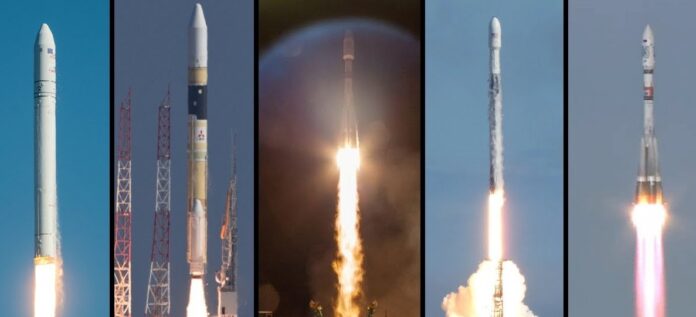In the past two months, I have written about plans to create spaceports and a global rocket transportation infrastructure. The idea of being able to travel from point to point anywhere on the planet in less than an hour versus transcontinental and transoceanic flights that take half a day or longer has a strong appeal. But are there unforeseen environmental consequences when we increase the volume of suborbital flights and trips to space?
Jet Aircraft Emissions and Climate Change
We know that jet aircraft have an atmospheric environmental impact. About 2.5% of the carbon dioxide (CO2) human activity emits into the atmosphere comes from commercial air traffic. That’s less than the emissions contributions of the marine industry at 3%, less than the cement industry at 4%, and less than steel at 5%. It is about equal to the emissions contribution of the infrastructure that supports today’s Internet. And even though global air traffic continues to rapidly increase, the CO2 percentage contribution from the industry in the overall emissions picture has remained approximately the same because all other human activities continue to add greenhouse gasses (GHGs) in parallel.
CO2 isn’t the only GHG coming from aircraft. Jet engine exhausts contain significant amounts of water vapour, nitrogen and sulphur oxides, carbon monoxide, unburned hydrocarbons, hydroxyls and soot which get added to the troposphere at extreme altitudes. If you don’t believe me just look at the contrails that follow a jet as it passes over.
Are jet aircraft emissions contributors to global warming or atmospheric cooling? The unburned hydrocarbons, carbon soot, combined with water vapour create aerosols similar to what an erupting volcano produces, but on a much smaller scale. Light-coloured aerosols in the upper atmosphere can reflect sunlight bouncing the heat energy back into space. But dark aerosols convert light energy into heat. So do these emissions cancel each other out?
When the World Trade Center was attacked in New York City on September 11, 2001, commercial jet aircraft were grounded for three days. Here in Toronto, Canada’s largest airport and transportation hub, we had the clearest skies over that period with scientists directly attributing the atmospheric conditions to the lack of jet aircraft in the skies.
The impact that jet aircraft emissions have on cloud formation remains an ongoing investigation. But one conclusion universally agreed to by scientists is that the cooling effects of atmospheric aerosols from air traffic do not counter the overall warming that other human emissions contribute to.
Rocket Emissions and Climate Change
Do rocket launches have a large carbon footprint? Would we have asked this question a few years ago considering the rate of launches at the time? No.
But the commercial space industry, as well as national space agency activities, have been increasing in launch volume raising this question. The deployment of SpaceX’s Starlink telecommunications network alone totals 14 launches in 2022 with more than a half year still ahead.
That’s why it makes sense to start looking at the environmental consequences coming from increased rocket launches. Rockets don’t produce large amounts of CO2. The fuel they use when burned produces less CO2 per kilogram than jet fuel. And at current launch levels, the totals represent 0.01% of our human global emissions contributions. So on the CO2 side of the carbon footprint ledger, rockets supplanting jet aircraft would be a good thing.
Rockets, however, fly through the stratosphere unlike aircraft and they emit soot and water vapour into the upper atmosphere. The addition of aerosols into the stratosphere is known to be climate forcing.
Based on the type of rocket fuel used, the GHG and pollution threats vary. For example, solid rockets produce chlorine gas as a byproduct. When introduced into the stratosphere, chlorine depletes ozone. NASA has studied the impact of solid rocket launches and noted the appearance of mini holes in the ozone layer after each. The Montreal Protocol was enacted late in the last century to stop ozone layer depletion caused by human activities. If we choose to use solid fuelled rockets to meet increasing demand, then we know there is a nascent environmental problem.
Another issue as a consequence of increased rocket launches is climate forcing, which also goes by the term, radiative forcing. Introducing change forces change. In this case, we are producing aerosols made of fine soot and water vapour and altering the energy balance in the upper atmosphere. We already know that jet aircraft do this in the troposphere, but we don’t have a handle on how climate forcing activities within the stratosphere will impact future global climate.
And there’s something else we don’t know. Each time a rocket returns from an orbital or suborbital flight the atmospheric friction created produces significant heat. What will be the net impact of an increase in the volume of suborbital and orbital flights? Imagine hundreds of launches and returns per year to support rocket cargo or space tourism flights and the footprint impressions start adding up.
SpaceX uses hydrocarbon-based methane as its rocket fuel. This year more than half of all rockets launched are adding more hydrocarbons into the atmosphere. But if the company were to switch to fuels using liquid hydrogen and liquid oxygen it would dramatically reduce the carbon footprint of every one of its launches.
Largely because we fly far more aircraft than we ride rockets, we can assume the impact of the latter will remain much smaller than that of the former. But as more commercial operators join the burgeoning space industry, we need to get a handle on the total footprint rockets will exert on the planet’s climate future.
Does the rocket industry need to be measuring its GHG contributions, tracking its carbon footprint, and reporting total emissions? Should we be asking all the players to establish a green standard for fuels and materials that impact the air column from launch to orbit? I think the answer to both is yes.









